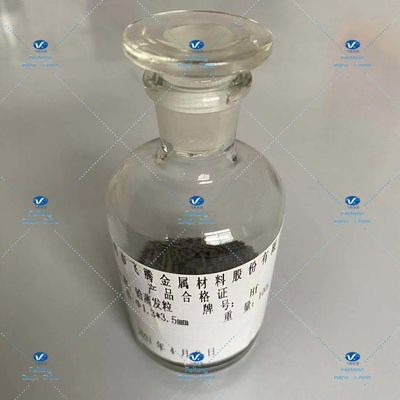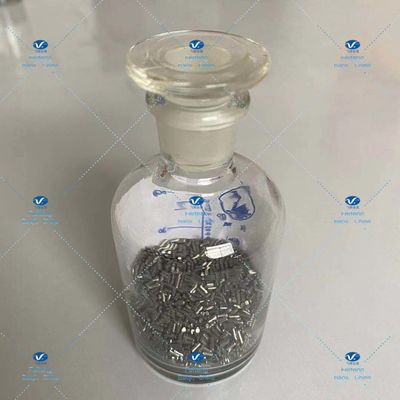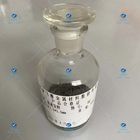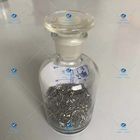ODM 1.3mm*3.5mm Hafnium Evaporation Pellets
| Place of Origin | Baoji, Shaanxi, China |
|---|---|
| Brand Name | Feiteng |
| Certification | GB/T19001-2016 idt ISO9001:2015 GJB9001C-2017 |
| Model Number | Hafnium Evaporation Pellets |
| Minimum Order Quantity | To be negotiated |
| Price | To be negotiated |
| Packaging Details | Vacuum |
| Delivery Time | To be negotiated |
| Payment Terms | T/T |
| Supply Ability | To be negotiated |

Contact me for free samples and coupons.
Whatsapp:0086 18588475571
Wechat: 0086 18588475571
Skype: sales10@aixton.com
If you have any concern, we provide 24-hour online help.
x| Port Of Delivery | Xi'an Port, Beijing Port, Shanghai Port, Guangzhou Port, Shenzhen Port | Brand Name | Feiteng |
|---|---|---|---|
| Certification | GB/T19001-2016 Idt ISO9001:2015 GJB9001C-2017 | Size | φ1.3*3.5 |
| Material | Hafnium | Packaging | Vacuum |
| Place Of Orgin | Baoji, Shaanxi, China | ||
| Highlight | 3.5mm Hafnium Evaporation Pellets,1.3mm Hafnium Evaporation Pellets,ODM Hafnium Pellets |
||
Hafnium 1.3*3.5 Evaporation Pellets Packaging Vacuum
| Port of delivery |
Xi'an port, Beijing port, Shanghai port, Guangzhou port, Shenzhen port |
| Material | Hafnium |
| Size | φ1.3*3.5 |
| Packaging | Vacuum |
Vacuum coating is an important aspect of vacuum applications. It is based on vacuum technology, which uses physical or chemical methods to absorb a series of new technologies, such as electron beam, molecular beam, ion beam, ion beam, radio frequency and magnetic control. It provides a new thin film preparation process for scientific research and practical production. In short, evaporation or sputtering of metals, alloys or compounds in vacuum can be cured and deposited on coated objects (called substrates, substrates or substrates), which is called vacuum coating.
Advantages:
(1) thin films and matrix materials are widely selected, which can control the thickness of films and prepare functional films with various functions.
(2) the thin film is prepared under vacuum condition. The environment is clean, and it is not easy to pollute. The film with good density, high purity and uniform film can be obtained.
(3) the bonding strength between the film and the substrate is good and the film is firm.
(4) Dry paint does not produce waste liquid and has no environmental pollution.
Vacuum coating technology mainly includes vacuum evaporation, vacuum sputtering, vacuum ion plating, vacuum beam deposition, chemical vapor deposition and so on. Besides CVD, other methods have the following common characteristics:
(1) All kinds of coating technologies require a specific vacuum environment to ensure the movement of the vapor molecules formed in the process of heating evaporation or sputtering, without the collision, blocking and interference of numerous gas molecules in the atmosphere, eliminating the harmful effects of impurities in the atmosphere.
(2) Various coating technologies require a evaporation source or target to evaporate the film material into a gas. Due to the continuous improvement of source or target, the selection range of membrane materials has been greatly expanded. Whether it is metal, metal alloy, intermetallic compound, ceramic or organic materials, various metal films and dielectric films can be evaporated, and different materials can be evaporated at the same time to obtain multilayer films.
(3) The film thickness can be measured and controlled more accurately in the process of film formation with the workpiece to be plated, to ensure the uniformity of the film thickness.
(4) The composition and mass fraction of residual gas of each film in the coating chamber can be accurately controlled through the fine-tuning valve, to prevent the oxidation of evaporated substances, minimize the mass fraction of oxygen, and fill inert gas, which is impossible for wet coating.
(5) Due to the continuous improvement of coating equipment, the coating process can be carried out continuously, which greatly improves the output of products and pollutes the environment in the production process.
(6) Due to the vacuum condition of the film, the film has high purity, good compactness and bright surface without processing, which makes the mechanical and chemical properties of the film better than electroplating film and chemical film.







